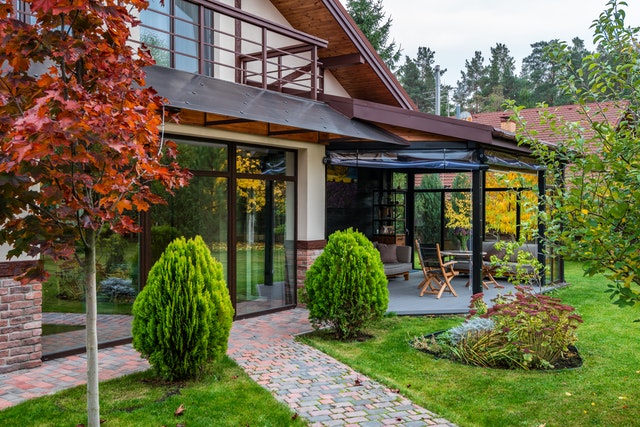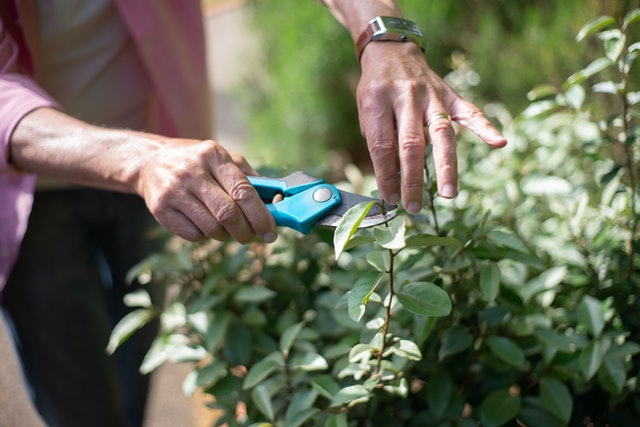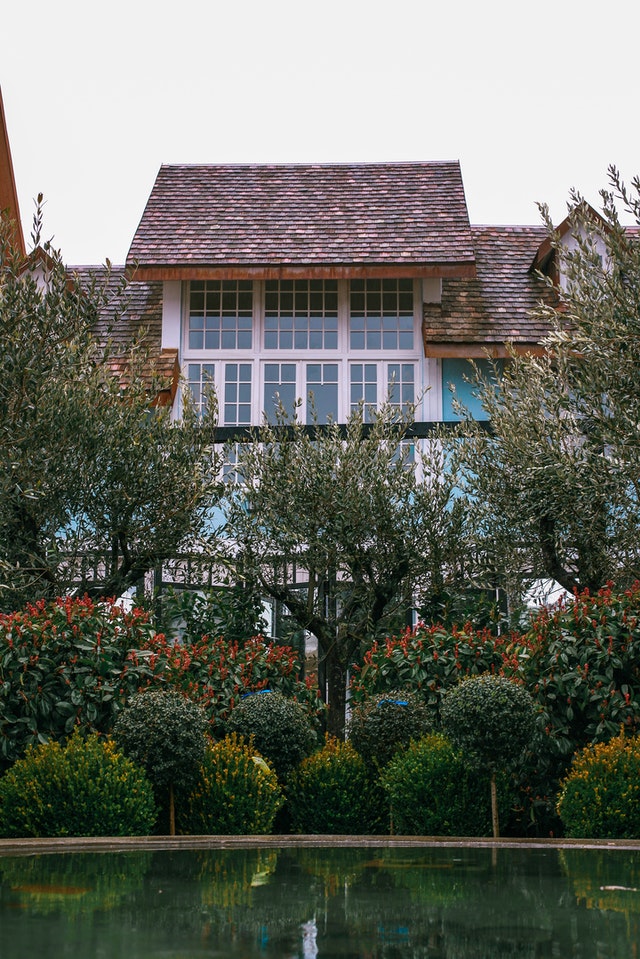Creative Pruning Close To Home
This is an excerpt from the Book called “Creative Pruning Close To Home” by Jake Hobson. Continue reading to learn more about Creative Pruning Close To Home, thanks to the author.
Decorative tree pruning and creative topiary exists in various guises all over the world: in the centuries old traditions of formal European topiary, in the garden tress of the far East, in the streets of San Francisco, and in the magical realist world of Zarcero in Costa Rica. The most interesting examples of these are found in gardens that, to me at least, do not subscribe to one particular style-ones that do not specifically declare themselves as topiary gardens, Japanese gardens or architectural gardens, but rather include elements from whatever takes their owner’s fancy.
Harvard Farm
For obvious reasons, I am particularly fond of my parent’s home in Dorset, Harvard Farm, in the south west of England. The garden was started from scratch in 1992, so it has only begun to reach maturity in the last few years. It is an informal, family garden, with a large trampoline parked firmly in the middle of the lawn throughout the year. Its foundations are the ragstone walls of the original farmyard, to which new retaining and ornamental walls were added, linking the garden to its surrounding Dorset landscape, as the ragstone itself was dug out of the heavy clay soil from under the garden-literally prized out with a crowbar, in some cases. Within the garden’s walls is what appears to be a quintessentially English garden: two lawns, borders, a spring wildflower meadow area, an apple tunnel, steps and terraces, and an enormous range of planting, all on a relaxed, informal scale. Bringing it all together, however, is a generous use of evergreens that were planted not just for their winter foliage, but also to establish some cover on the windy, hilltop site.

It is these evergreens that we are interested in here. Like all gardeners faced with an empty plot and an eager enthusiasm, Mum overplanted. As the plants finally got going, there was the inevitable natural selection process, as the losers were gradually weeded out, but still there was too much for the garden. Mum knew that she wanted strong, clipped shapes, but it just so happened that I came back from my spell in Japan at exactly the time that these evergreens needed some serious attention. Phillyrea latifolia, quercus ilex, Osmanthus X burk-woodii, Laurus nobilis, Ilex aquifolium, Elaeagnus X ebbingei, Lonicera nitida, of course Buxus Sempervirens, and various other conifers, notably Taxus baccata and species of Cupressus. These had all finally become established in the heavy clay soil and strong winds, and were busily blocking pathways and crowding out other plants. My suggestion was to incorporate some of what I had learned in Japan into the garden, experimenting with Japanese techniques on these decidedly un-Japanese plants.
The results, we think, work very well. Some shapes are clearly Japanese in style, others are less intentional and more organic, but what they all do is fit into the garden as a landscape. Deliberately niwaki-styled Phillyrea latifolia sit at crucial points on the corners of buildings. A row of yew twmps evolved almost accidentally out of a hedge that refused to corporate, as some plants in the row struggled to establish themselves in our clay. Large, bloated Elaeagnus X ebbingei kidneys frame views onto the lawn and down towards the twmps, like bladders ready to burst. Buxus Sempervirens shapes are dotted about the border, no two alike. Come winter, with the garden reduced to its bare bones, these shapes assume a new importance. Where in mind summer, their role is to offer a contrast to the rich, varied planting around them, in the winter they take centre stage, particularly on clear frosty mornings in the low, winter light.
The clipping process is now shared out among everyone available. I started most projects, but have moved away since them. My father, an artist, adds his own perspective to things when he gets going. Rob, the gardener, does more than anyone, and Mum, busy with the borders, takes care of the smaller jobs. Timing is based on manpower and necessity rather than a well-planned policy. Family events and open days during the summer mean things sometimes get clipped earlier or later than perhaps they should, but in a family garden that is how it works.
At every turn in the garden, strong, organic shapes provide structure, framing views, adding definition to the planting schemes and linking the garden with the landscape beyond: the rolling hills and hedgerows of the Dorset countryside. Despite the amount of clipping that goes on, Mum is adamant that this is no topiary garden, but what it proves is that there is room in almost any garden for a bit of creative pruning. It can be light hearted and fun without being tacky, and it can be clever and sophisticated without being overpowering, adding character and an extra element to the garden without dominating it.
The view of the drive, seen from the front door, shows how clipped shapes and evergreens interact well with foliage and color. Some shapes, such as the Phillyrea latifolia niwaki, are kept tight and well clipped throughout the year, while others, such as the Rhamnus alaternus pyramid are only clipped once a year, allowing the edges to blur. Weeping willow, Eriobotrya japonica, variegated evergreen and deciduous Elaeagnus , a red Prunus, roses, even yuccas, and the young ash plantation behind, all act as a foil for the strongly clipped shapes in the foreground.
It is interesting to compare this view of the drive with that of one of my favourite gardens in Kyoto, the temple of Konchi-in-not because our garden, not yet 20 years old, could possibly compare with one of the more important temple gardens in Kyoto, built over 400 years ago, but because elements of it are remarkably similar. The basic physical layout and topography is very alike: the flat foreground, the blank and taller trees behind. Of course, the temple gravel gets raked each morning, and has no cars turning on it, but what both pictures show is that strong, clipped shapes can interact well with the mixture of foliage, colour and texture, adding a sense of focus and depth.
The Japanese-style Phillyrea latifolia are a particular feature of the garden, and work well against the stone farmhouse and outbuildings. Phillyrea is a great choice for this sort of pruning as its foliage is dense, evergreen and relatively small. They get clipped twice a year, once in early summer (quite a hard clip, cutting right back to the original outlines, to keep the branches from getting too big) and then again at the end of the summer, usually sometime in September. As with all evergreens, they drop a lot of old yellow leaves in the early summer, just when they are putting on their growth spurt, so it pays to give them a good shake when pruning, to encourage them off-there is nothing worse than having a good pruning session, tidying up and then the next day seeing more mess from fallen leaves.
Between the terrace and the top lawn, a low, worm-like Lonicera nitida hedge merges into a larger thorn hedge, adding to the informal feel of the garden and creating lovely gateways to two pathways and steps down to the terrace. Lonicera is a fantastic option if you want fast results for a hedge, but it grows amazingly quickly and fairly messily-it needs constant pruning and once established, benefits from clipping at least once a month through later spring to early autumn. Frankly, I have better things to do with my time than tending to it.
The apple tunnel, inspired by the one at Heale House in Wiltshire, England, consists of a steel frame and a collection of favourite apples trained over the arches and espaliered along wires. The apples cover the entire season, from Discovery right up to Jonagold, and get pruned twice a year-the woody growth is thinned over the winter and the soft growth cut back midsummer to help the fruit to ripen. Both sides of the tunnel are flanked by rows of irregular Buxus Sempervirens shapes. They are intentionally not prefect balls, but lumpy, organic things that create a softer, more relaxed feel-and are much easier to clip. They get dealt with just once a year, clipped with an electric hedge trimmer in early summer.
The border, meanwhile, is packed full of colour and foliage, as well as a few large standards (Laurus nobilis and Pittosporum tenuifolium) that are raised above the level of the herbaceous plants. One bay is being cloud pruned, bit-by-bit. It stared off as a predictable, bushy, egg shape, but was taking up too much valuable space. Rather than raising it into a standard lollipop or mushroom (the obvious solution, but we already had two standards in the border), we decided to give it a more Japanese look and it has proven to be successful material for this kind of treatment-even though because of its vigour and the size of its leaves, each branch needs to be on a fairly large scale. Using Japanese techniques on a plant so strongly associated with the Mediterranean might seem like a contradiction, but then the English garden has never been the place to worry about dilemmas like that and it certainly does not bother us.
Various green and variegated box is scattered throughout the front of the border, in random shapes that have suggested themselves over the years: irregular spirals and helter-skelters, strange ball-on-cube-on-plinth shapes and cones that have slowly morphed into teardrops, so much so that they now resemble fat penguins. They are all placed towards the front of the border, and in the summer their role constantly changes as the plants around them grow and flower. Their early summer clip sharpens them, bringing them into focus and adding their distinct outlines that in turn give a sense of depth to the border they sit in. Over the course of the summer they lose their edge, putting on that slightly annoying second flush of growth that fails to grow evenly all over, appearing instead in patches of light green. A few minutes with a pair of shears puts an end to this, bringing things back into focus, but nevertheless an autumn clip freshens everything up for the winter.
Around the back of the large barn, which is used as a painting studio by my father, lurk yet more surprises. A pair of Cupressus arizonica var. glabra flank the doors to the barn, clipped into very deliberate Japanese taamazukuri forms. They started off life as typical conifers shapes, and over three or four years were clipped and shaped until they reached their finished condition. The yew twmps opposite them are the result of a less than successful hedge. Young plants were planted in what is basically reclaimed, heavily compressed clay soil-not the best start for nay plants, let alone yew. Over the years they got established, but never in a uniform manner that suggested a formal hedge, so as much out of impatience as anything else, we started clipping individual plants. They are at their best seen obliquely, especially on a frosty winter morning. The advantage of this irregular style, beyond its visual strengths, is that weaker plants can be pruned into smaller shapes or removed altogether, without upsetting the balance of things. Nor do mistakes through heavy-handed pruning stand out as strongly as in formal hedges, and uncertainties can always be ironed out later on.
The garden was designed to create different areas, and views, at every turn. From the lawns, glimpses of views offer themselves in all directions, usually defined by the topiary-the sharp outline of clipped box balls against the house, peeking out from under the shade of a fig tree, or the random arrangement of cones and domes on the terrace (bay, Elaeagnus and Phillyrea) like the roof-scape of a Renaissance town. A pair of small Phillyrea trees sitting in the corner of the lower lawn have some-how escaped pruning altogether. One day something will be done about them, but for now they exist in their natural form, overseeing all around them.





